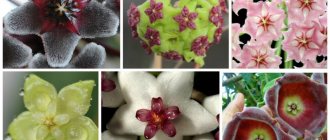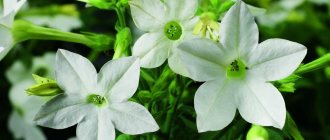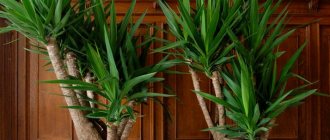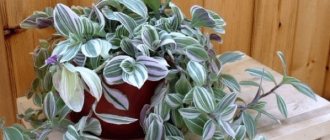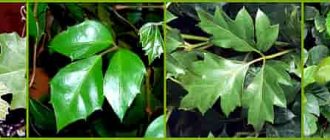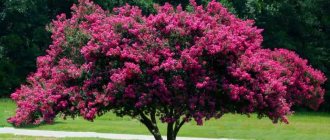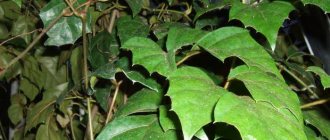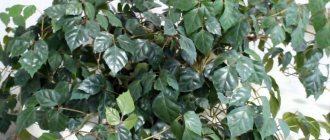Sansevieria is a genus from the Asparagaceae family. This unusual evergreen plant does not have a stem, but has strong, leathery leaves decorated with a striped pattern. In many species the leaves are shaped like a sword. Some types of sansevieria reach a height of 150 cm, others are real crumbs up to 20 cm high. But it is the tall species that are popular in indoor floriculture. And the reason is that this plant can decorate the house even in the most difficult conditions and with virtually no care.
Sansevieria is valued not only for its beauty and unpretentious nature, it purifies the air and actively absorbs carbon dioxide and formaldehyde. According to the latest scientific research data, this particular plant is recommended to be grown in residential buildings with plastic windows.
Popular are the species and forms with leaves of light and dark green, cream or yellow stripes along the edge, and silver-green leaves lined with dark stripes. The most common species in indoor culture is Sansevieria three-lane.
Types and varieties of Sansevieria
The genus Sansevieria has about 70 species. However, such diversity is available only to botanical greenhouses. Nevertheless, the ease of cultivation gives impetus to the creation of more and more new varieties and hybrids of sansevieria (1).
Sansevieria cylindrica
Sansevieria cylindrica is a designer favorite. With its help you can make any interior original in a minimalist style. The plant is very graphic and sculptural. Straight, rounded, cone-shaped leaves with a deep longitudinal groove, dark green, with a pattern - they are collected in dense basal rosettes. Even the flower brush is designed in the style of modern minimalism - a stem up to 50 cm high with small cream lily flowers attached to it (2).
Perhaps this is the best flower for high-tech style. But not only external data is suitable for a modern interior. The plant itself and its unpretentious nature give a chance to have a houseplant even for those who work a lot and leave their home for a long time.
This type of sansevieria has several interesting varieties:
- Mikado - a variety with light green leaves with dark green transverse stripes;
- Spike - differs in that the leaves do not grow in a rosette, but separately from the trunk;
- Patens is the smallest variety with leaves up to 30 cm, which are arranged in a fan;
- Twister - has leaves up to 1 m high, they are so flexible that this particular variety is braided.
– This type of sansevieria is often sold in the form of leaves intertwined into complex shapes (braids). Often the tips of its leaves are painted in different colors, but this does not benefit the plant; it is better not to take such specimens, says plant collector Elizaveta Starostina.
Sansevieria cylindrical. Photo: commons.wikimedia.org
Sansevieria cylindrical variety Twister. Photo: screenshot from video youtube.com
Sansevieria three-lane
Sansevieria trifasciata is the most common species native to South Africa. These plants began to be grown as early as the 13th century. A powerful, spectacular plant with lanceolate or sword-shaped variegated leaves up to 1.5 m high. The plant has a powerful root system. In April-May, white-green or pink-violet flowers appear in the form of miniature lilies. During the flowering period at night, the room is filled with the aroma of vanilla.
This sansevieria has many interesting varieties:
Black Gold - has a wide yellow stripe along the edge of the leaf;
Black Coral (BlackCoral) is a beautiful variety with dark green leaves with a shaded pattern up to 60 cm high;
Golden Flame is one of the most beautiful varieties with leaves resembling the shape and color of a fire flame;
Laurenti (Laurentii) is one of the oldest varieties with powerful leaves up to 10 cm wide, bordered by a yellow stripe;
Futura Superba (Futura Superba) is a plant 40 - 45 cm high with massive light green leaves widening towards the middle with dark transverse strokes;
Moonshine or Moon - almost white leaves with a silvery tint with blurred transverse stripes grow from underground rosettes.
Hanni group (Sansevieria hahnii) - an artificially created variety in 1941 named after its parent S. Khan today includes a whole line of varieties - these are compact hybrids up to 30 cm in height with vase-shaped rosettes, wide and short leaves, bent outward and sharp tips . They practically do not bloom; they differ mainly in the color of the leaf blades. Most popular:
- Golden Hunny (Golden hahnii) - with wide golden stripes along the edges of the leaf blades;
- Silver Hunny (Silver hahnii) - with silvery leaves in dark blurry stripes;
- Cristata hahnii - has speckled green leaves that curl toward the center;
- Cream Hanni (Cream hahnii) - with silver-green leaves and a cream stripe along the edge;
- Sticker Hunny (Streaker hahnii) – has small dark green leaves and a yellow stripe down the center.
Sansevieria Laurenti. Photo: globallookpress.com
Sansevieria Golden Honey. Photo: screenshot from video youtube.com
Sansevieria Christata Hanni. Photo: screenshot from video youtube.com
Sansevieria Kirki
Sansevieria kirkii is not recognized by all experts as an independent species - it is often classified as a three-lane Sansevieria species. Externally, it is distinguished by long, pointed leaves with striking light leaves (white or yellowish), with shaded irregular green stripes. The edges of the leaf blade are slightly wavy with a contrasting edge color. The appearance of this sansevieria resembles a star. It blooms very impressively - many pale flowers open above the green leaves, collected in large umbrellas.
Popular varieties:
- Blue - has fleshy oval-lanceolate leaves with a pointed tip, they are green with a silvery tint and a marbled pattern of spots and stripes;
- Coppertone - a variety with emerald-colored leaves that become brown over time;
- Friends - distinguished by its compact size, dense rosette of narrow (1 - 2.5 cm) dark green leaves with a blurry light green pattern up to 25 cm long.
Sansevieria Silver Blue. Photo: screenshot from video youtube.com
Sansevieria Coppertone. Photo: screenshot from video youtube.com
Sansevieria bacularis
Sansevieria bacularis (Sansevieria bacularis) is a rare species with thin (1 - 2 cm in diameter) and hard leathery leaves up to 1.5 m high. Their main color is dark green, the transverse stripes are much lighter. The first description of this species from South Africa was given only in 2010.
Sansevieria bacularis. Photo: screenshot from video youtube.com
Sansevieria masoniana
Sansevieria masoniana is native to the Congo and is often sold under the name Congo Mason. It has characteristic wide leaves, up to 60 cm high, lobed, dark green or gray with blurry light green spots and a unique fibrous purple edge. Often grown as one large, tough leaf, it is also called "shark fin". One of the best species for growing in low light.
In the collections of gardeners you can find a variegated form of this sansevieria, in which half of the leaf is painted golden.
Sansevieria masoniana. Photo: screenshot from video youtube.com
Sansevieria zeilanica
Sansevieria zeylanica is a hybrid isolated as a separate species, although some botanists consider it just a variety of three-lane Sansevieria. This is one of the most beautiful plants loved by florists. It has beautiful wide leaves up to 40 cm long with spectacular silver specks and wavy stripes. The leaves grow from the root, as if overlapping each other, forming a fan.
Stem forms of Sansevieria
The vast majority of Sansevieria species have short shoots, but there are exceptions. There are stem sansevierias that have 2 types of shoots:
- vertical and short stems, clasped along their entire length by leaf bases.
- aerial shoots or stolons, at the ends of which leaf rosettes develop.
Sansevieria Graceful or Graceful
This species is characterized by the presence of a small (6 cm) round shoot from which vaginal leaves arise. The leaf blades are short (up to 30 cm), wide, oval and fleshy, with an elongated pointed apex, rolled into a tube. The leaves are colored in shades of green with a gray tint and are pierced with transverse stripes of a dark green hue.
A few shoots develop from the base of the stem, enhancing the impression of the gracefulness of the plant.
Sansevieria Graceful blooms in spring or autumn, forming insignificant light flowers with a faint aroma. Suitable for growing on windowsills
Pinguecula or Walking Sansevieria
The presence of a trunk and a special, not typical for most Sansevieria, arrangement of leaves of an original shape became the reason for the origin of the name of this species.
- Pinguecula has large and thick leaves with a slightly elongated sharp end and a contrasting edging.
- Leaf rosettes develop on stolons extending in different directions from the main trunk. With their help, the plant develops nearby territories or “walks.”
Bali
A species of stem sansevieria, named after its discoverer, Peter Bali (Switzerland). Outwardly, it is similar to Walking Sansevieria, differing:
- thicker (succulent) shoots up to 5 cm long;
- short (20-50 cm) and rounded leaves with fused edges and conical tops, painted dark green, with transverse silver-green stripes, color.
Sanseviera francisi
One of the few stem forms with a creeping shoot, from which cylindrical leaves, dark green at the base and rough to the touch, extend in rows. The pointed leaf blades extend to a height of 30 to 60 cm.
The look looks original and impressive in hanging pots and flowerpots.
Caring for Sansevieria at home
Sansevieria is a very hardy plant; you can safely buy it as the first plant for your home. Even a not very diligent and responsible child can cope with its cultivation.
It is important to know that this plant tolerates dry indoor air well and loves moderate temperatures.
Priming
Ready-made soil for roses is suitable for growing sansevieria, but loosening materials should be added to it - coarse river sand or perlite. You can also use soil for cacti and succulents.
Lighting
Young plants need diffused sunlight, adults tolerate low light, so pots of sansevieria can be placed on the floor, in places in the house away from windows. However, it should be understood that the less illuminated the place, the weaker the pattern and color of the plant will be expressed. Therefore, it is better to grow valuable varieties with unusual leaf colors in bright places.
If you grow sansevieria in a shaded place, then for its successful growth in spring and early autumn, move the pot to a windowsill in the south-east or south-west direction for a month.
Humidity
Sansevieria does not like excess moisture. When watering, you need to ensure that drops of water do not fall into the middle of the outlet. From spring to autumn, water the plant moderately, once a week; immediately after watering, drain the water from the pan. In winter, water very rarely, when the soil dries to a depth of 3 - 4 cm.
Sansevieria is not sprayed, but the leaves are wiped with a damp cloth at least once a week. And this is not necessary for moisturizing, but for removing dust (2).
In summer, sansevieria can be taken out onto the balcony or into the garden, but be sure to protect it from direct sunlight and take it indoors if night temperatures drop below 5°C.
Fertilizers
To grow sansevieria, use universal fertilizers for decorative foliage plants.
Feeding
For intensive growth, fertilize in the spring-summer period with fertilizers for decorative deciduous plants, but not more than once every 3-4 weeks. In winter, plants are not fed.
Trimming
Sansevieria is pruned only when the leaf becomes sick or damaged, and the rosette with the peduncle begins to die. To do this, disinfect a sharp knife and carefully cut out a leaf or rosette at the very base. The cut is dusted with crushed coal. Do not water for the next 3 - 5 days.
Diseases and pests of mother-in-law's tongue
This plant does not get sick very often and problems mostly arise as a result of improper care. It is worth reviewing the conditions of keeping Sansevieria if the following signs occur:
- the leaves are covered with dark spots - most often this happens when the plant receives more water than it needs at a low temperature;
- yellowing of foliage - the most likely reason lies in lack of lighting or too small a container;
- the tips of the leaves become yellow, wither and dry out - due to insufficient light, excessive watering or too low air temperature;
- the leaf plate has become soft and bends - perhaps the flower has stretched closer to the light and the leaves have ceased to support their own weight;
- the foliage curls - a sign that watering is too infrequent and the succulent does not have enough moisture.
Not always correcting care can solve the problem, since succulents, although infrequently, can still be affected by pests:
- the flower turns pale, acquires a yellow tint, and its leaves become covered with whitish spots - this is most likely about the sansa being infected with spider mites; will save the plant from the parasite by wiping the foliage with a damp cloth and treating it with insecticidal agents, prevention - regular air humidification;
- the appearance of light spots on the outer side of the plate and the presence of larvae on the other - the flower is infected with small insects, thrips; they can be removed using insecticides;
- yellowing and curvature of foliage and peduncles - hairy lice, also known as mealybugs, have reached the flower; in case of a small infestation, it is enough to remove the pest with your hands and wipe the damaged areas with a damp cloth; if the lesions are significant, then insecticides cannot be avoided.
Reproduction of Sansevieria at home
Sansevieria propagates quite easily, not only by lateral shoots and division of rhizomes, but also by leaf cuttings. In principle, it is possible to grow sansevieria from seeds, but they are not sold, and it is rarely possible to obtain seeds yourself.
By dividing the rhizomes. It is produced during transplants, in the spring. Side shoots are separated by cutting with a piece of root. All sections are dusted with crushed charcoal and the rhizomes or shoots are planted in pots with regular soil for sansevieria. For 7 - 10 days, the pot is covered with film, then the cover is gradually removed. Water into the tray as the soil dries.
By cuttings. To grow sansevieria, take a leaf from cuttings and cut it into pieces 10 cm long, immerse the cuttings 2/3 in damp sand or perlite and cover with a jar. Keep them in a warm, bright place. Every day the jar is raised for ventilation for literally 5 - 7 minutes. Water only into the tray of the pot. The roots grow in about 30 - 40 days, then buds appear, from which leaves develop. When 2-3 leaves appear, the plants are planted in permanent pots with fertile soil.
Transplanting Sansevieria at home
The first transplant - from a pot with transport soil - is carried out 14 - 30 days after purchase. Young plants are replanted annually, in spring, in April. From the age of over 5 years, replanting can be done once every 3 years, when the roots protruding from the pot are already visible.
Ready-made soil for roses is suitable for sansevieria. Or they can be made independently from turf soil, peat and coarse sand or perlite (3:1:1).
The pot needs to be low and wide, because the root system is powerful, but superficial. Be sure to be stable and heavy, preferably ceramic.
“Mature plants are heavy, so they need a pot that is resistant to tipping over; they often require support for tying up leaves,” says plant collector Elizaveta Starostina. – Flower growers often include sansevieria in compositions with hanging or ground cover plants. In this case, I advise you to use wide flat pots or boxes, and enrich the soil with the addition of 1 part compost or vermicompost.
Sansevieria diseases
Anthracnose. It appears on the leaves in the form of small depressed brown spots. If measures are not taken in time, the spots will begin to increase and the leaf will dry out.
The affected plant is removed from the pot. Wash the leaves and roots in a pink solution of potassium permanganate. Then they are transplanted into fresh soil, sprayed with a solution of Fitosporin-M and the soil is watered with it. The surface of the soil is sprinkled with coarse sand.
Root rot . This disease leads to rotting of the roots and bases of leaves. It is difficult to treat, so it is better to take care of prevention - moderate soil moisture and protection from pests.
At the first signs of disease, transplant the plants into fresh soil, cutting out the damaged areas and disinfecting the pot.
Fusarium. It manifests itself in the fact that small watery spots appear on young leaves of Sansevieria. Gradually they grow and change color to red.
If action is not taken quickly, the plant will die. It is urgent to replant it in fresh soil, after washing the roots and disinfecting the pot. Cut out all sore spots with a sharp knife and treat the sections with Fukortsin or brilliant green. Adjust temperature, light and watering. Spray plants with Fitosporin-M solution 2 - 3 times with an interval of 10 days.
Transplantation and propagation
In my house, all the window sills are filled with this plant; even for me, who only have cacti to survive, it is not at all problematic. I remembered - I watered it, I forgot - it sits there and doesn’t ask for anything. Pots on different windowsills - on the east, south side, in the sun, in partial shade - feel good everywhere.
Replanting is not a problem at all - I look - new shoots have come out, there is dough for the flower - I carefully take it out, separate it and replant it in a new pot. I use the usual universal substrate. Once I even took garden soil and disinfected it with potassium permanganate - and everything was fine.
Pests of Sansevieria
Mealybug. It is primarily found in the rosette and at the base of the leaves.
To begin with, the plant is washed in warm water, washing off the cotton wool-like coating. Then wipe the pest accumulation areas with a cotton swab dipped in alcohol. If possible, treat the plant with Actellik or Fufanon (3).
Thrips. They settle on the underside of leaves and feed on plant juices. The leaves take on a grayish-brown hue with a silvery sheen.
To protect the plant, spray 2-3 times with an interval of 10-14 days with Actellik (3).
Shield. It is easy to detect by looking closely at the leaves - it looks like dense brownish tubercles.
To begin with, pests are collected by hand, then the leaves are wiped with a cotton pad soaked in alcohol. If possible, plants are sprayed twice with an interval of 10 - 14 days with Actellik or Fitoverm (3).
Description of the plant
This flower is popularly called “pike tail”, or “mother-in-law’s tongue”, “cuckoo tail”, “devil’s tongue”, and you can also find many other names. More than sixty varieties of this plant have been bred, but only a few of them are most common in home pots.
The flower does not require much care; it can even go without watering for quite a long time. In addition, it is believed that “mother-in-law’s tongue” is one of the plants in which oxygen production is considered to be maximum. The culture looks great in any interior and is absolutely safe for children and pets.
To ensure that the plant does not stop growing after moving to another room, it should be gradually accustomed to new lighting and air temperature.
Sansevieria belongs to the Agave family. The plant is characterized by thick, long leaves of various colors.
The flower originates from savannas and subtropics. The ideal climate for it is in Asia, Madagascar, India, as well as in the countries of Central Africa. That is why in our country this plant is grown only in pots. The culture simply will not survive in open ground, even despite its unpretentiousness.
The leaves of Sansevieria are thick, have a rather dense structure, and look like gloss. As for colors, there are a huge number of them, depending on the type of plant. Mostly these are green and brown shades with varying numbers of stripes, and can also be interspersed.
The length of the leaves reaches one meter. They are often slightly pointed at the ends. The arrangement of the plates is also significantly different. Leaves can be in a vertical, horizontal direction, or looking sideways.
Sansevieria flowers are green and white. Their petals are quite narrow and have long stamens. The peduncle grows very tall, and there are gorgeous inflorescences on it. The aroma when flowering is simply divine, a bit reminiscent of vanilla. The buds generally open in the afternoon, and at night you can fully enjoy the excellent aromas. Unfortunately, when grown indoors, this plant almost never bears fruit.
